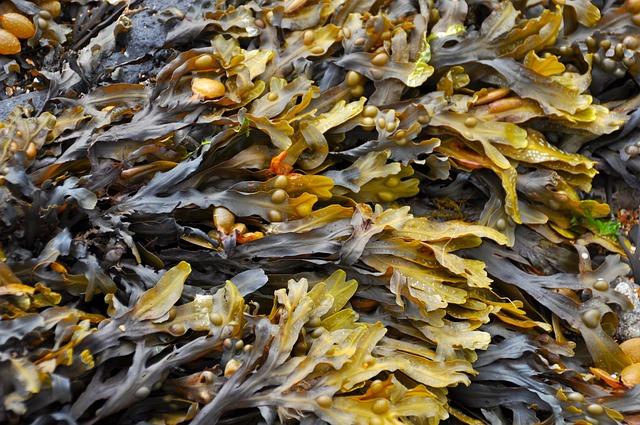In the depths of the ocean, among the swaying fronds of brown algae, lies a remarkable compound known as fucoxanthin—a carotenoid pigment that not only lends color to thes marine plants but may also hold the key to unlocking new pathways in weight management and metabolic health. As scientists increasingly turn their attention to the natural world for innovative solutions to contemporary health challenges, fucoxanthin has emerged as a interesting subject of study, especially for its potential effects on thermogenesis, the bodyS process of heat production. This exploration into fucoxanthin seaweed extract delves into the mechanisms behind its thermogenic properties, evaluating how the unique biochemistry of brown algae could contribute to the future of nutritional science and weight loss therapies.Join us as we journey through the sea’s hidden treasures, uncovering the science behind this intriguing marine-derived superfood and its implications for human health.
Exploring the Thermogenic Potential of Fucoxanthin in Brown Algae
Fucoxanthin, a carotenoid pigment abundantly found in brown algae, has gained attention for its potential role in promoting thermogenesis—an essential metabolic process that helps regulate body temperature and burn calories. Research indicates that the unique structure of fucoxanthin enables it to influence various metabolic pathways, particularly in adipose tissues.When activated, this compound stimulates the production of uncoupling protein 1 (UCP1), which is primarily located in brown fat tissue, facilitating the conversion of stored fat into heat. This thermogenic effect not only contributes to weight management but may also enhance overall energy expenditure, making fucoxanthin a fascinating subject in nutritional science.
Incorporating fucoxanthin-rich seaweed extracts into one’s diet can be both delicious and beneficial.Brown algae, such as wakame and hijiki, are not only culinary delights but also packed with bioactive compounds that support healthy metabolism. To truly understand the impact of fucoxanthin on thermogenesis, several factors should be considered, including:
- Concentration of Fucoxanthin: The effectiveness varies depending on the amount present in the algae.
- Antioxidant Properties: Fucoxanthin’s ability to combat oxidative stress may enhance metabolic health.
- Complementary nutrients: The synergistic effects of other vitamins and minerals in brown algae can amplify fat-burning effects.
Below is a concise overview of various types of brown algae and their fucoxanthin content:
| Type of Brown Algae | Fucoxanthin Content (mg/100g) |
|---|---|
| Wakame (Undaria pinnatifida) | 5-10 |
| Hijiki (Sargassum fusiforme) | 3-6 |
| Kombu (Laminaria japonica) | 1-4 |
Mechanisms of Action: How Fucoxanthin Enhances metabolic Activity
Fucoxanthin, a carotenoid pigment found in brown algae, has garnered attention for its potential to boost metabolic activity through several intriguing mechanisms. This remarkable compound is thought to activate mitochondrial function, promoting the generation of heat through a process known as thermogenesis. By enhancing the expression of thermogenic proteins such as UCP1 (uncoupling protein 1), fucoxanthin plays a pivotal role in the regulation of energy expenditure, which may assist in weight management and fat loss. additionally, it has been shown to modulate the metabolism of lipids, encouraging the breakdown of stored fats while potentially suppressing the formation of new fat cells, thereby contributing to a leaner body composition.
Moreover, fucoxanthin’s role extends beyond mere fat oxidation. research indicates that it may influence metabolic enzymes, such as AMPK (AMP-activated protein kinase), which is crucial in managing energy balance within cells. By stimulating AMPK activation,fucoxanthin helps to enhance glucose uptake and utilization,leading to improved insulin sensitivity. This dual action not only boosts energy levels but also supports cardiovascular health by maintaining healthy glucose metabolism. To further illustrate the benefits of fucoxanthin on metabolic activity,consider the following table showcasing key components involved in its action:
| Mechanism | Effect |
|---|---|
| Mitochondrial Activation | Increased thermogenesis and energy expenditure |
| UCP1 Expression | Enhanced fat oxidation |
| AMPK Activation | improved glucose metabolism and insulin sensitivity |
Health Benefits and Nutritional Profile of Fucoxanthin Seaweed Extract
Fucoxanthin,a natural pigment found in brown seaweeds,offers a remarkable array of health benefits that are drawing increased attention in the nutrition and wellness fields.Known for its potential to stimulate thermogenesis, fucoxanthin may play a vital role in enhancing metabolic rate and energy expenditure. This unique compound has been shown to promote fat oxidation,making it a promising ally in weight management. Additionally, early studies suggest that fucoxanthin possesses anti-inflammatory and antioxidant properties, which can contribute to overall health by combating oxidative stress and potentially reducing the risk of chronic diseases.
The nutritional profile of fucoxanthin seaweed extract is as intriguing as its active components. It is rich in essential nutrients such as vitamins and minerals, including iodine, magnesium, calcium, and iron.Below is a brief comparison table highlighting the key nutritional aspects of fucoxanthin seaweed extract:
| Nutrient | Per 100g of Raw seaweed |
|---|---|
| Caloric Content | 45 kcal |
| Protein | 5g |
| Dietary Fiber | 30g |
| Omega-3 Fatty Acids | 0.3g |
this combination of high nutritional value and bioactive compounds positions fucoxanthin seaweed extract as a compelling addition to a balanced diet.Its potential synergistic effects on health underscore the significance of incorporating brown algae into modern dietary practices.
Practical Recommendations for Incorporating Fucoxanthin into Your Diet
Incorporating fucoxanthin into your daily diet can be both enjoyable and beneficial for your health. Here are some practical ways to seamlessly add this powerful compound derived from brown algae to your meals:
- Seaweed Salads: Use dried or fresh seaweed such as wakame or dulse as a base for salads. Pair with sesame oil, rice vinegar, and your favorite veggies for a refreshing dish.
- Smoothies: Blend a small amount of powdered fucoxanthin with your favorite fruits, greens, and a plant-based milk to create a nutrient-dense drink.
- Soups: add seaweed or fucoxanthin supplements to warm soups. Miso soup with a sprinkle of seaweed can enhance flavor and nutrition.
- As a Supplement: If convenience is key, consider fucoxanthin capsules or powder that can be mixed into drinks or yogurts for an easy boost.
It’s also vital to be mindful of the quantities you consume. here’s a simple guide for recommended daily intake options:
| Source | Recommended daily Intake |
|---|---|
| Whole Seaweed | 1-2 servings (1-2 grams) |
| Fucoxanthin Powder | 300-500 mg |
| Fucoxanthin Capsules | 1-2 capsules |
Ultimately, finding the right balance and incorporating fucoxanthin into your diet can provide a tasty and healthful experience. Explore different recipes and ways to infuse this marine marvel into your meals and enjoy the benefits of a diversified nutrient intake.
The Way Forward
the exploration of fucoxanthin derived from brown algae unveils a fascinating intersection of nature and science, revealing its potential in promoting thermogenesis and weight management. As researchers continue to delve into the myriad benefits of this vibrant compound, the promise of fucoxanthin extends beyond mere weight loss, suggesting broader implications for metabolic health and wellness.The synergy between ancient marine life and contemporary health science represents not just an innovative nutritional avenue, but also a reminder of the untapped resources our oceans hold. As we stand on the brink of deeper understanding, the journey into the depths of fucoxanthin’s promise is just beginning, one that invites curiosity and careful study.






